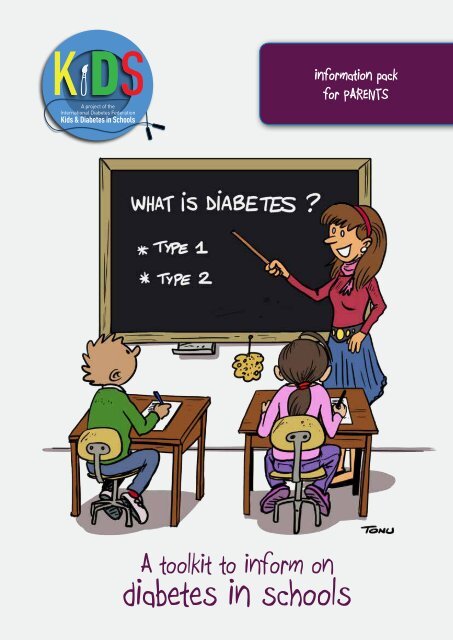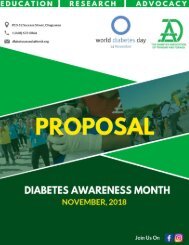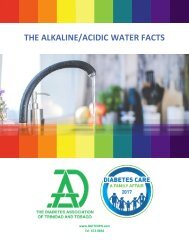DATT Primary School Diabetes Quiz (KiDs Booklet)
Study this booklet then answer the questions posted on the Diabetes Association of T&T Facebook Page
Study this booklet then answer the questions posted on the Diabetes Association of T&T Facebook Page
You also want an ePaper? Increase the reach of your titles
YUMPU automatically turns print PDFs into web optimized ePapers that Google loves.
A toolkit to inform on<br />
diabetes in schools<br />
information pack<br />
for PARENTS
Acknowledgements:<br />
This material has been developed in<br />
collaboration with the members of the<br />
KiDS Advisory Committee:<br />
Monika Arora, Anne Belton, David Cavan, David<br />
Chaney, Daniela Chinnici, Stephen A. Greene,<br />
Agnès Magnen, Angie Middlehurst, Denise Reis<br />
Franco, Nikhil Tandon, Sara Webber.<br />
Publication coordinators: David Chaney,<br />
Daniela Chinnici (kids@idf.org)<br />
Illustrations: Frédéric Thonar (alias Tonu)<br />
www.tonu.be<br />
Layout: Olivier Jacqmain (Publications<br />
Manager of IDF)<br />
Partners :<br />
PARENTS<br />
Guidelines:<br />
This pack should be used in tandem with<br />
an information session and is not intended<br />
to be distributed as a standalone item. A<br />
programme on diabetes education should<br />
be organised at schools around the pack.<br />
Endorsed by:<br />
diabetes.ca | 1-800-BANTING<br />
The Canadian <strong>Diabetes</strong> Association supports the<br />
International <strong>Diabetes</strong> Federation’s KiDS pack<br />
to ensure the health and safety of children with<br />
diabetes and to help them be full and equal<br />
school participants without fear of exclusion,<br />
stigmatization or discrimination.<br />
IDF gratefully acknowledges the support<br />
of Sanofi in this project.<br />
If you wish to translate the pack into<br />
further languages or make culturally<br />
specific adaptations, please notify<br />
IDF before any changes are made:<br />
communications@idf.org.<br />
IDF, ISPAD and Sanofi <strong>Diabetes</strong> logos<br />
must remain visible on this material.<br />
If you have a new local partner that<br />
endorses the project, make sure to seek<br />
IDF permission before adding new logos<br />
on the pack.<br />
We would appreciate your feedback<br />
on pack usage and photos from your<br />
information sessions.<br />
No fees will be asked for using this pack.<br />
<strong>Diabetes</strong> Information Pack for <strong>School</strong>s A TOOLKIT TO INFORM ON DIABETES IN SCHOOLS 68
TABLE OF CONTENTS<br />
Introduction<br />
ƢƢ<br />
What is diabetes?<br />
A day in the life of Tom, living with type 1 diabetes.<br />
ƢƢ<br />
What is type 1 diabetes?<br />
ƢƢ<br />
What is type 2 diabetes?<br />
ƢƢ<br />
Why do people need to prevent and take care of diabetes?<br />
ƢƢ<br />
Why is it important to choose a healthy lifestyle?<br />
ƢƢ<br />
How to stay healthy? Eat well, move well.<br />
ƢƢ<br />
Ressource website<br />
PARENTS<br />
<strong>Diabetes</strong> Information Pack for <strong>School</strong>s A TOOLKIT TO INFORM ON DIABETES IN SCHOOLS 69
INTRODUCTION<br />
The following KiDS information pack will guide you in making the school<br />
environment a better place for children with diabetes. The pack is an<br />
awareness and information tool created to inform you about diabetes. This<br />
pack should be seen purely as an information resource.<br />
This pack is not intended to replace the advice of the diabetes team.<br />
Increase awareness of<br />
diabetes in school<br />
Improve the lives of children<br />
with diabetes at school and fight<br />
discrimination<br />
THE AIM OF THIS PACK IS TO:<br />
PARENTS<br />
Help teachers address the topic<br />
of diabetes and need for a<br />
healthy lifestyle<br />
Why a blue circle?<br />
The icon was designed as a call to<br />
unite for diabetes and is a symbol<br />
of support for the UN Resolution on<br />
<strong>Diabetes</strong>. The colour blue represents<br />
the sky and it is the same colour as<br />
the flag of the United Nations.<br />
<strong>Diabetes</strong> Information Pack for <strong>School</strong>s A TOOLKIT TO INFORM ON DIABETES IN SCHOOLS 70
PARENTS<br />
WHAT IS DIABETES?<br />
A day in life of Tom, living with type 1 diabetes<br />
<strong>Diabetes</strong> Information Pack for <strong>School</strong>s A TOOLKIT TO INFORM ON DIABETES IN SCHOOLS 71
<strong>Diabetes</strong> Information Pack for <strong>School</strong>s A TOOLKIT TO INFORM ON DIABETES IN SCHOOLS 72<br />
PARENTS
<strong>Diabetes</strong> Information Pack for <strong>School</strong>s A TOOLKIT TO INFORM ON DIABETES IN SCHOOLS 73<br />
PARENTS
<strong>Diabetes</strong> Information Pack for <strong>School</strong>s A TOOLKIT TO INFORM ON DIABETES IN SCHOOLS 74<br />
PARENTS
WHAT IS TYPE 1<br />
DIABETES?<br />
<strong>Diabetes</strong><br />
can develop in a child<br />
of any age, including infants and<br />
toddlers. Type 1 diabetes often develops<br />
quickly and may be life-threatening if not<br />
diagnosed early.<br />
Type 1<br />
diabetes is<br />
diagnosed when the pancreas<br />
stops making insulin completely.<br />
It is an autoimmune disease which<br />
means the body’s own immune system<br />
attacks the pancreas destroying the cells<br />
that make insulin. This results in the<br />
body being unable to control the<br />
amount of glucose in the<br />
blood.<br />
PARENTS<br />
<strong>Diabetes</strong> Information Pack for <strong>School</strong>s A TOOLKIT TO INFORM ON DIABETES IN SCHOOLS 75
WHAT IS TYPE 2<br />
DIABETES?<br />
Type 2<br />
diabetes is<br />
diagnosed when the body<br />
does not produce enough insulin to<br />
function properly, or the body’s cells<br />
Type 2<br />
diabetes is being<br />
diagnosed in children in a growing<br />
number of countries. In the United<br />
States, up to 1 in 3 new cases of type<br />
2 diabetes, is diagnosed in youth<br />
younger than 18.<br />
don’t react to insulin. This is known as<br />
insulin resistance. If this happens,<br />
the body is unable to control the<br />
amount of glucose in the<br />
blood.<br />
PARENTS<br />
SYMPTOMS:<br />
Unlike type 1, in people with type 2<br />
diabetes the symptoms are often<br />
mild or absent, making this type<br />
of diabetes hard to detect.<br />
In general the most common signs are<br />
WEIGHT LOSS<br />
<strong>Diabetes</strong> Information Pack for <strong>School</strong>s A TOOLKIT TO INFORM ON DIABETES IN SCHOOLS 76
WHY DO PEOPLE NEED<br />
TO PREVENT & TAKE CARE<br />
OF DIABETES?<br />
BECAUSE IT CAN<br />
LEAD TO :<br />
damage to the retina<br />
PARENTS<br />
foot problems<br />
Kidney disease<br />
<strong>Diabetes</strong> Information Pack for <strong>School</strong>s A TOOLKIT TO INFORM ON DIABETES IN SCHOOLS 77
PARENTS<br />
WHY IS IT IMPORTANT<br />
TO CHOOSE A HEALTHY<br />
LIFESTYLE?<br />
TO PREVENT:<br />
<strong>Diabetes</strong> Information Pack for <strong>School</strong>s A TOOLKIT TO INFORM ON DIABETES IN SCHOOLS 78
HOW TO STAY HEALTHY?<br />
EAT WELL<br />
There is a lot of evidence that lifestyle changes can help<br />
prevent the development of type 2 diabetes.<br />
33 %<br />
33 %<br />
PARENTS<br />
12 %<br />
15 %<br />
7 %<br />
Try to remember these proportions in your daily meals.<br />
<strong>Diabetes</strong> Information Pack for <strong>School</strong>s A TOOLKIT TO INFORM ON DIABETES IN SCHOOLS 79
HOW TO STAY HEALTHY?<br />
MOVE WELL<br />
A healthy diet is built on a base of regular physical activity,<br />
which keeps calories in balance and weight in check.<br />
TIPS<br />
TO GET ACTIVE:<br />
Ƣ Choose a sport you like<br />
Ƣ Set regular times for activities;<br />
make it a part of your daily schedule<br />
Ƣ Reduce use of screen time (TV, computers etc..)<br />
and play with friends<br />
Ƣ Walk to school<br />
Ƣ Take the stairs instead of an elevator<br />
Ƣ Learn to use the skateboard, the bike or<br />
run instead of getting a ride<br />
Ƣ Walk the dog with<br />
your parents<br />
PARENTS<br />
Ƣ Turn off your<br />
TV, smart phone or<br />
computer and spend some<br />
time to play with your friends<br />
Ƣ Stay active: do a minimum of 30<br />
minutes of exercise per day<br />
Ƣ Exercise with a<br />
friend<br />
<strong>Diabetes</strong> Information Pack for <strong>School</strong>s A TOOLKIT TO INFORM ON DIABETES IN SCHOOLS 80
RESOURCE WEBSITES<br />
ƢƢ<br />
http://ndep.nih.gov/publications/PublicationDetail.aspx?PubId=97#main<br />
ƢƢ<br />
http://t1dstars.com/web/;<br />
ƢƢ<br />
http://www.diabeteskidsandteens.com.au/staycoolatschool.html<br />
ƢƢ<br />
http://main.diabetes.org/dorg/advocate/Back_to_<strong>School</strong>_August_2013/<br />
lib/playback.html<br />
ƢƢ<br />
https://www.diabetescamps.org/ugc/page-body/doc/JDRF%20<strong>School</strong>%20<br />
Advisory%20Toolkit.pdf<br />
PARENTS<br />
<strong>Diabetes</strong> Information Pack for <strong>School</strong>s A TOOLKIT TO INFORM ON DIABETES IN SCHOOLS 81
A toolkit to inform on<br />
diabetes in schools<br />
information pack<br />
for CHILDREN
Acknowledgements:<br />
This material has been developed in<br />
collaboration with the members of the<br />
KiDS Advisory Committee:<br />
Monika Arora, Anne Belton, David Cavan, David<br />
Chaney, Daniela Chinnici, Stephen A. Greene,<br />
Agnès Magnen, Angie Middlehurst, Denise Reis<br />
Franco, Nikhil Tandon, Sara Webber.<br />
Publication coordinators: David Chaney,<br />
Daniela Chinnici (kids@idf.org)<br />
Illustrations: Frédéric Thonar (alias Tonu)<br />
www.tonu.be<br />
Layout: Olivier Jacqmain (Publications<br />
Manager of IDF)<br />
Partners :<br />
Guidelines:<br />
This pack should be used in tandem with<br />
an information session and is not intended<br />
to be distributed as a standalone item. A<br />
programme on diabetes education should<br />
be organised at schools around the pack.<br />
CHILDREN<br />
Endorsed by:<br />
diabetes.ca | 1-800-BANTING<br />
The Canadian <strong>Diabetes</strong> Association supports the<br />
International <strong>Diabetes</strong> Federation’s KiDS pack<br />
to ensure the health and safety of children with<br />
diabetes and to help them be full and equal<br />
school participants without fear of exclusion,<br />
stigmatization or discrimination.<br />
IDF gratefully acknowledges the support<br />
of Sanofi in this project.<br />
If you wish to translate the pack into<br />
further languages or make culturally<br />
specific adaptations, please notify<br />
IDF before any changes are made:<br />
communications@idf.org.<br />
IDF, ISPAD and Sanofi <strong>Diabetes</strong> logos<br />
must remain visible on this material.<br />
If you have a new local partner that<br />
endorses the project, make sure to seek<br />
IDF permission before adding new logos<br />
on the pack.<br />
We would appreciate your feedback<br />
on pack usage and photos from your<br />
information sessions.<br />
No fees will be asked for using this pack.<br />
<strong>Diabetes</strong> Information Pack for <strong>School</strong>s A TOOLKIT TO INFORM ON DIABETES IN SCHOOLS 83
CHILDREN<br />
WHAT IS DIABETES?<br />
A day in the life of Tom, living with type 1 diabetes<br />
<strong>Diabetes</strong> Information Pack for <strong>School</strong>s A TOOLKIT TO INFORM ON DIABETES IN SCHOOLS 84
<strong>Diabetes</strong> Information Pack for <strong>School</strong>s A TOOLKIT TO INFORM ON DIABETES IN SCHOOLS 85<br />
CHILDREN
<strong>Diabetes</strong> Information Pack for <strong>School</strong>s A TOOLKIT TO INFORM ON DIABETES IN SCHOOLS 86<br />
CHILDREN
<strong>Diabetes</strong> Information Pack for <strong>School</strong>s A TOOLKIT TO INFORM ON DIABETES IN SCHOOLS 87<br />
CHILDREN
CHILDREN<br />
WHY IS IT IMPORTANT<br />
TO CHOOSE A HEALTHY<br />
LIFESTYLE?<br />
TO PREVENT:<br />
<strong>Diabetes</strong> Information Pack for <strong>School</strong>s A TOOLKIT TO INFORM ON DIABETES IN SCHOOLS 88
CHILDREN<br />
HOW TO STAY HEALTHY?<br />
EAT WELL<br />
How to choose healthy food?<br />
33 %<br />
33 %<br />
12 % 15 %<br />
7 %<br />
Try to remember these proportions in your daily meals.<br />
<strong>Diabetes</strong> Information Pack for <strong>School</strong>s A TOOLKIT TO INFORM ON DIABETES IN SCHOOLS 89
HOW TO STAY HEALTHY?<br />
MOVE WELL<br />
A healthy diet is built on a base of regular physical activity,<br />
which keeps calories in balance and weight in check.<br />
TIPS TO GET ACTIVE:<br />
Ƣ Try sports and choose a sport you like<br />
Ƣ Set regular times for activities;<br />
make it a part of your daily schedule<br />
Ƣ Reduce use of screen time (TV, computers etc..)<br />
and play with friends<br />
Ƣ Walk to school<br />
Ƣ Take the stairs instead of an elevator<br />
Ƣ Learn to use the skateboard, the bike or<br />
run instead of getting a ride<br />
Ƣ Walk the dog with<br />
your parents<br />
CHILDREN<br />
Ƣ Turn off your<br />
TV, smart phone or<br />
computer and spend some<br />
time playing with your friends<br />
Ƣ Stay active: do a minimum of 30<br />
minutes of exercise per day<br />
Ƣ Exercise with a<br />
friend<br />
<strong>Diabetes</strong> Information Pack for <strong>School</strong>s A TOOLKIT TO INFORM ON DIABETES IN SCHOOLS 90








